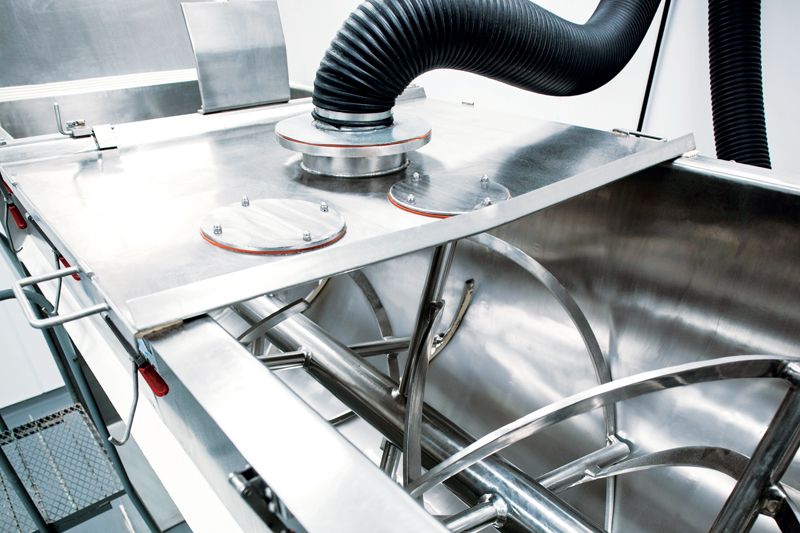5 Ways to Buy a Blender for Nutraceutical Products
Ask the expert: Nutraceutical manufacturers, here are five ways to obtain the equipment you need, when you need it.
Photo: The quick discharge, easy cleaning, and low risk of cross-contamination facilitated by a sanitary design and finish are especially important for a high-volume contract manufacturer. This blender is also equipped with dust collection to promote a clean working environment for the manufacturing team.

By Chris Ross, Vice President, Charles Ross & Son Company
Looking for a way to optimize production and product quality, most process engineers focus on what’s right in front of them: their process line and the equipment they’ll need to meet their production goals. But behind every production decision is a business decision that balances operational benefits with up-front costs, cash flow, and capital risk. Smart production choices are matched by equally smart business choices, and to make smart choices you need to know all your options. Here are five ways to obtain the equipment you need, when you need it.
1. New Equipment Purchase, Built to Order
The most obvious way to obtain a blender is to buy it direct from a manufacturer. This gives you an opportunity to customize the design of your blender and control system to match your production environment. It also allows you to test the unit in a laboratory before you buy it to confirm your choice and reduce risk. And, of course, a new equipment purchase gives you a brand new piece of machinery with a warranty, technical service, and all the additional support you may need for control integration and startup.
2. New Equipment Purchase from Stock
If you need more production capacity immediately, purchasing a blender that will be built to order may not be your best choice. A new blender built to order is typically delivered in 8–10 weeks following approval of engineering drawings.
You can avoid this delay if you’re working with a manufacturer who stocks new equipment for sale. Buying from stock, you may have to compromise on such details as the blender’s capacity and the bells and whistles that come with it. But a little flexibility may get you a blender with 90% of the features you’re looking for, in just a few days.
Actually, you may not have to compromise for long. Some manufacturers will also agree to provide a new (or used) blender from stock to help solve your immediate need while your new blender is being built, then swap it out later when your new blender is ready for delivery and startup. This is the best of both worlds.
3. Used Equipment Purchase from Stock
Your blender manufacturer may occasionally stock used equipment. Ask for a used blender built originally by this manufacturer. Ideally, you want a unit that is fully refurbished to meet its original specs and backed with a strong warranty. No one knows a blender better than its original manufacturer, so this gives you excellent quality assurance.
4. Equipment Rental with Option to Buy
Especially for a small or mid-sized company, the cost of a new blender may seem like a huge commitment standing on a foundation of uncertainty. Are you sure demand will continue to grow and justify this new equipment? Of course not. Projections are never 100% certain, so you may want to mitigate this uncertainty by renting the equipment you need instead of buying it.
A trial/rental-in your own plant, using your ingredients, prior to purchase-is also useful to confirm that you’ve chosen the right blender to buy for your operation.
Look for a rental deal that will give you an option to purchase the equipment when your rental period is over. You should expect to apply a substantial portion of your rental fees toward the purchase.
5. Used Equipment Purchase on the Open Market
Companies on a steep growth curve with many important purchases required to support rapid expansion must decide where to assign priorities and apply precious resources. Often there just isn’t enough cash on hand to buy everything they need from an OEM.
The least expensive alternative is to buy a used blender from another manufacturing company or a used-equipment vendor. These units generally come with little quality assurance, but when you’re just getting started, compromises are a fact of life.
Be sure to choose a blender that was built by a high-quality manufacturer, and check its service history to make sure it was maintained properly. Look for signs of excessive wear, too, which may give you problems with difficult cleaning, off-spec production, or contamination between batches.
Photo courtesy of SDC Nutrition
HHS announces restructuring plans to consolidate divisions and downsize workforce
Published: March 27th 2025 | Updated: March 27th 2025According to the announcement, the restructuring will save taxpayers $1.8 billion per year by reducing the workforce by 10,000 full-time employees and consolidating the department’s 28 divisions into 15 new divisions.










